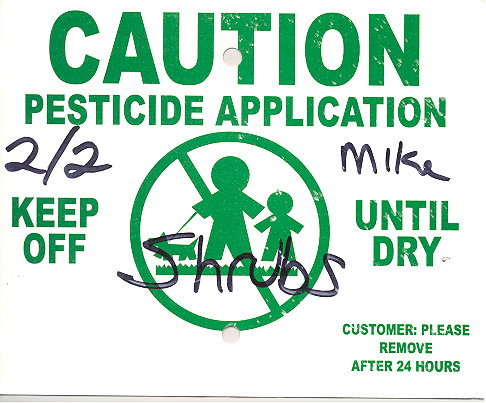Watering in of pesticides and fertilizers as required by the manufacturer of the product is allowed on any day. However, signs must be posted on the lawn and the date of the application must be written clearly on the sign (See sample below). These applications are not restricted to the appointed irrigation day, but it is recommended to plan applications around your irrigation schedule (not rain events).

According to Green-Industry Best Management Practices, do not apply fertilizers or pesticides prior to a large rain event. While it is recommended these applications be watered into the landscape, only a quarter of an inch of water is necessary. Any more than that and most of the product will leach too far into the soil, becoming unavailable for plant use. This practice will also cut down on the amount of pesticide and fertilizer that gets washed away in storm water runoff. By following the manufacturer label directions on any product applied to your lawn and landscape, you can help minimize pollution and give your plants the best possible growing conditions.
Do not fertilize dormant or non-growing turfgrass, usually seen during winter months.
Fertilizer Best Management Practices for Turfgrass and Landscape
- Do not fertilize if a heavy rainfall is expected, especially tropical or frontal weather systems.
- Match the product to the situation. After ruling out other issues such as too much shade, overwatering, or other stresses that may be effecting your plants, do a soil test to verify fertilizing is the correct response. This will also help determine what kind of product you need.
- Read the label thoroughly!
- Know your yard. Measure the square footage of the area you need to fertilize, follow the label directions for application amount and make sure your spreader/equipment is properly cleaned and calibrated. Remember that more does not always mean better.
- Irrigate 1/4 inch following fertilization to avoid the loss of nitrogen and increase uptake efficiency. Without proper irrigation, you risk volatilization (the loss of applied nitrogen to the atmosphere as ammonia gas) and inefficient use of fertilizer.
- Ensure fertilizer is not left around impervious areas such as streets, driveways, or sidewalks. These areas allow the fertilizer to runoff into storm drains and bodies of water.
- Always leave a Ring of Responsibility, a preventative buffer that protects against accidental direct contamination of bodies of water. With liquid fertilizers this is at least 3 feet from the edge of the water. Granular fertilizers need to be kept 10 feet from shorelines. Deflector shields can be used when broadcasting.
Pesticide Best Management Practices for Turfgrass and Landscape
- Always observe label directions, restrictions, and precautions. It is dangerous, wasteful, and illegal to do otherwise.
- Store pesticides behind locked doors in original containers with labels intact, separate from seed and fertilizer.
- Use pesticides at the correct application rate and recommended intervals between applications.
- Never eat, drink, or smoke when handling pesticides, and always wash with soap and water after use.
- Triple-rinse containers into the spray tank. Never pour pesticides down the drain or into an area exposed to humans, animals, or water.
- Dispose of used containers in compliance with label directions so that water contamination and other hazards will not result.
- Always wear protective clothing when applying pesticides. At a minimum, wear a long-sleeved shirt, long-legged pants, rubber gloves, boots (never go barefoot or wear sandals), eye protection, and a wide-brimmed hat. Additional protective gear may be listed on the pesticide label.